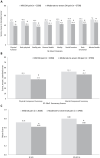Moderate to Severe Osteoarthritis Pain and Its Impact on Patients in the United States: A National Survey
- PMID: 34349555
- PMCID: PMC8326774
- DOI: 10.2147/JPR.S310368
Moderate to Severe Osteoarthritis Pain and Its Impact on Patients in the United States: A National Survey
Abstract
Purpose: Osteoarthritis (OA) is one of the most common causes of chronic pain and a leading cause of disability in the US. The objective of this study was to examine the clinical and economic burden of OA by pain severity.
Patients and methods: We used nationally representative survey data. Adults ≥18 years with self-reported physician-diagnosed OA and experiencing OA pain were included in the study. OA pain severity was measured using the Short Form McGill Pain Questionnaire Visual Analog Scale (SF-MPQ-VAS). Data were collected for demographics, clinical characteristics, health-related quality of life (HRQoL), productivity, OA treatment, adherence to pain medication, and healthcare resource utilization. Univariate analysis was performed to examine differences between respondents with moderate-to-severe OA pain vs those with mild OA pain.
Results: Higher proportions of respondents with moderate-to-severe OA pain (n=3798) compared with mild OA pain (n=2038) were female (69.4% vs 57.3%), <65 years of age (54.8% vs 43.4%), and not employed (70.6% vs 64.5%). Respondents with moderate-to-severe OA pain experienced OA pain daily (80.8% vs 48.8%), were obese (53.0% vs 40.5%), had more comorbidities (sleep disturbance, insomnia, depression, and anxiety), and reported significantly poorer health status and HRQoL, and greater productivity and activity impairment (all P<0.05). Moderate-to-severe OA pain respondents were prescribed significantly more pain medications than mild OA pain respondents (41.0% vs 17.0%) and had higher adherence (75.9% vs 64.1%) yet were less satisfied with their pain medications (all P<0.001). Outpatient and emergency room visits, and hospitalizations in the 6 months prior to the survey were significantly higher in moderate-to-severe OA pain respondents vs those with mild OA pain (all P<0.05).
Conclusion: Patient and clinical burden was significantly greater in moderate-to-severe OA pain respondents vs mild OA pain respondents and may inform decision-making for appropriate resource allocation and effective management strategies that target specific subgroups.
Keywords: HCRU; HRQoL; health-related quality of life; healthcare resource utilization; medication adherence; moderate-to-severe pain; osteoarthritis; pain severity; treatment satisfaction.
© 2021 Schepman et al.
Conflict of interest statement
The findings of this manuscript have been presented at the ISPOR 2020 Virtual Annual Meeting; May 18–20, 2020 and at PAINWeek 2020 Virtual Meeting; September 11–13, 2020. The following authors are employees of Pfizer with stock and/or stock options: PS, ST, CB, DM, and BE. RR is an employee and stockholder of Eli Lilly and Company. AS was financially compensated for providing editorial support in the drafting of this manuscript. The authors report no other conflicts of interest in this work.
Figures






References
-
- United States Bone and Joint Initiative. Osteoarthritis. The Burden of Musculoskeletal Diseases in the United States (BMUS). Rosemont, IL; 2018: Available from: https://www.boneandjointburden.org/fourth-edition. Accessed January14, 2020.
LinkOut - more resources
Full Text Sources

